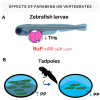Environmental Endocrinology: Parabens Hazardous Effects on Hypothalamic-Pituitary-Thyroid Axis
- PMID: 37894927
- PMCID: PMC10607526
- DOI: 10.3390/ijms242015246
Environmental Endocrinology: Parabens Hazardous Effects on Hypothalamic-Pituitary-Thyroid Axis
Abstract
Parabens are classified as endocrine-disrupting chemicals (EDCs) capable of interfering with the normal functioning of the thyroid, affecting the proper regulation of the biosynthesis of thyroid hormones (THs), which is controlled by the hypothalamic-pituitary-thyroid axis (HPT). Given the crucial role of these hormones in health and the growing evidence of diseases related to thyroid dysfunction, this review looks at the effects of paraben exposure on the thyroid. In this study, we considered research carried out in vitro and in vivo and epidemiological studies published between 1951 and 2023, which demonstrated an association between exposure to parabens and dysfunctions of the HPT axis. In humans, exposure to parabens increases thyroid-stimulating hormone (TSH) levels, while exposure decreases TSH levels in rodents. The effects on THs levels are also poorly described, as well as peripheral metabolism. Regardless, recent studies have shown different actions between different subtypes of parabens on the HPT axis, which allows us to speculate that the mechanism of action of these parabens is different. Furthermore, studies of exposure to parabens are more evident in women than in men. Therefore, future studies are needed to clarify the effects of exposure to parabens and their mechanisms of action on this axis.
Keywords: endocrine disruptor; hypothalamus–pituitary–thyroid axis; parabens; thyroid; toxicity.
Conflict of interest statement
The authors declare no conflict of interest.
Figures



Similar articles
-
Associations between paraben exposure, thyroid capacity, homeostasis and pituitary thyrotropic function in the general Taiwanese: Taiwan Environmental Survey for Toxicants (TEST) 2013.Environ Sci Pollut Res Int. 2024 Jan;31(1):1288-1303. doi: 10.1007/s11356-023-31277-y. Epub 2023 Dec 1. Environ Sci Pollut Res Int. 2024. PMID: 38038926
-
Sex-specific association of exposure to a mixture of phenols, parabens, and phthalates with thyroid hormone and antibody levels in US adolescents and adults.Environ Sci Pollut Res Int. 2023 Dec;30(57):121207-121223. doi: 10.1007/s11356-023-30739-7. Epub 2023 Nov 11. Environ Sci Pollut Res Int. 2023. PMID: 37950782
-
Perinatal exposure to glyphosate-based herbicide alters the thyrotrophic axis and causes thyroid hormone homeostasis imbalance in male rats.Toxicology. 2017 Feb 15;377:25-37. doi: 10.1016/j.tox.2016.11.005. Epub 2016 Dec 1. Toxicology. 2017. PMID: 27916585
-
Fasting-induced changes in the hypothalamus-pituitary-thyroid axis.Thyroid. 2008 Feb;18(2):123-9. doi: 10.1089/thy.2007.0253. Thyroid. 2008. PMID: 18225975 Review.
-
Central regulation of the hypothalamo-pituitary-thyroid (HPT) axis: focus on clinical aspects.Handb Clin Neurol. 2014;124:127-38. doi: 10.1016/B978-0-444-59602-4.00009-5. Handb Clin Neurol. 2014. PMID: 25248584 Review.
Cited by
-
Endocrine-Disrupting Chemicals, Hypothalamic Inflammation and Reproductive Outcomes: A Review of the Literature.Int J Mol Sci. 2024 Oct 22;25(21):11344. doi: 10.3390/ijms252111344. Int J Mol Sci. 2024. PMID: 39518897 Free PMC article. Review.
-
Investigating methylparaben's oxidative stress effects on rainbow trout blood, liver, and kidney toxicity.Onderstepoort J Vet Res. 2025 Mar 7;92(1):e1-e7. doi: 10.4102/ojvr.v92i1.2200. Onderstepoort J Vet Res. 2025. PMID: 40171681 Free PMC article.
-
Environmental Toxicology and Human Health.Int J Mol Sci. 2023 Dec 31;25(1):555. doi: 10.3390/ijms25010555. Int J Mol Sci. 2023. PMID: 38203725 Free PMC article.
-
Epigenetic Mechanisms of Endocrine-Disrupting Chemicals in Breast Cancer and Their Impact on Dietary Intake.J Xenobiot. 2024 Dec 24;15(1):1. doi: 10.3390/jox15010001. J Xenobiot. 2024. PMID: 39846533 Free PMC article. Review.
-
Exposure assessment of dairy cows to parabens using hair samples analysis.Sci Rep. 2024 Jun 21;14(1):14291. doi: 10.1038/s41598-024-65347-z. Sci Rep. 2024. PMID: 38906953 Free PMC article.
References
Publication types
MeSH terms
Substances
Grants and funding
- CNE-FAPERJ E-26/200.798/2021/Fundação Carlos Chagas Filho de Amparo à Pesquisa do Estado do Rio de Janeiro
- Programa de Redes de Pesquisa em Saúde do Estado do Rio de Janeiro-2019 E-26/010.002429/2019/Fundação Carlos Chagas Filho de Amparo à Pesquisa do Estado do Rio de Janeiro
- Programa de Apoio a Projetos Temáticos no Estado do Rio de Janeiro E-26/211.265/2021/Fundação Carlos Chagas Filho de Amparo à Pesquisa do Estado do Rio de Janeiro
- DBCA grant 88887.683091/2022-00/Coordenação de Aperfeicoamento de Pessoal de Nível Superior
- DSA grant 88887.683092/2022-00/Coordenação de Aperfeicoamento de Pessoal de Nível Superior
LinkOut - more resources
Full Text Sources

